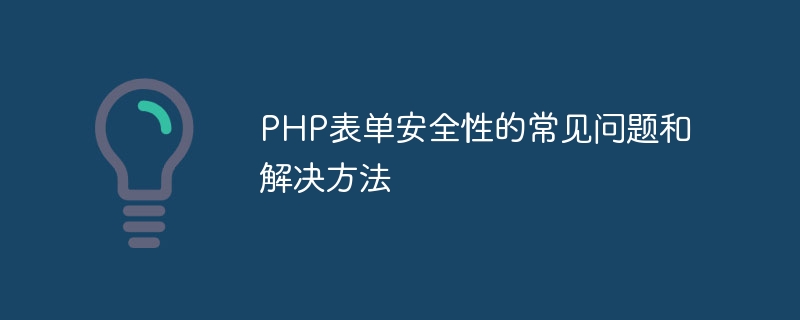

Common problems and solutions to PHP form security
With the development of the Internet, more and more websites and applications use PHP to process user-submitted Form data. However, due to the lack of adequate security measures, PHP forms are often easy targets for malicious attacks. This article will introduce common problems with PHP form security and provide corresponding solutions.
1. Cross-site scripting attack (XSS)
Cross-site scripting attack is a common network security vulnerability. Attackers use website vulnerabilities to inject malicious scripts into users. These scripts will be executed in the user's browser to steal the user's sensitive information or perform other malicious behaviors.
Solution:
$name = htmlspecialchars($_POST['name']);
echo strip_tags($name);
2. SQL injection attack
SQL injection attack means that the attacker injects SQL code into the input form to modify the database or obtain sensitive data. Purpose. This is a common attack method that poses a potential threat to the security of websites and user information.
Solution:
$stmt = $pdo->prepare('SELECT * FROM users WHERE username = :name');
$stmt->bindParam(':name', $name);
$stmt->execute();$name = mysqli_real_escape_string($conn, $_POST['name']);
3. Form Forgery (CSRF)
The form forgery attack is an attack method that uses the user's identity to submit malicious requests without knowing it. Attackers forge requests and perform illegal actions by obtaining user login credentials.
Workaround:
<form action="submit.php" method="post"> <input type="hidden" name="csrf_token" value="<?php echo $_SESSION['csrf_token']; ?>"> <!-- 其他表单元素 --> <input type="submit" value="提交"> </form>
session_start();
if ($_SERVER['REQUEST_METHOD'] === 'POST') {
if ($_POST['csrf_token'] === $_SESSION['csrf_token']) {
// 验证通过
} else {
// 验证失败,可能是CSRF攻击
}
}if (isset($_SERVER['HTTP_REFERER']) && parse_url($_SERVER['HTTP_REFERER'], PHP_URL_HOST) === 'example.com') {
// 合法的来源,允许提交表单
} else {
// 非法的来源,可能是CSRF攻击
}In summary, PHP form security issues mainly include cross-site scripting attacks, SQL injection attacks and form forgery issues. Through methods such as input and output filtering, parameterized query pre-compilation, and the use of CSRF tokens, these common attack methods can be effectively prevented and the security of users and websites protected. When developing PHP applications, it is crucial to keep security in mind.
The above is the detailed content of Frequently Asked Questions and Solutions for PHP Forms Security. For more information, please follow other related articles on the PHP Chinese website!
 How to set up a secure VPS
How to set up a secure VPS
 How to cancel Douyin account on Douyin
How to cancel Douyin account on Douyin
 MySQL error 1171 solution
MySQL error 1171 solution
 How to buy and sell Bitcoin in China
How to buy and sell Bitcoin in China
 Ranking of foreign CDN service providers
Ranking of foreign CDN service providers
 Registration domain name query tool
Registration domain name query tool
 Introduction to virtualization software
Introduction to virtualization software
 What to do if the embedded image is not displayed completely
What to do if the embedded image is not displayed completely




